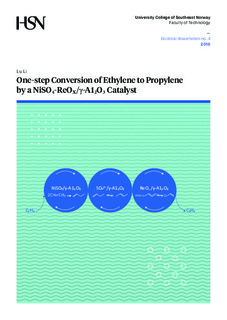| dc.contributor.author | Li, Lu | |
| dc.date.accessioned | 2018-08-08T20:55:50Z | |
| dc.date.available | 2018-08-08T20:55:50Z | |
| dc.date.issued | 2016-06-22 | |
| dc.identifier.isbn | 978-82-7206-413-5 | |
| dc.identifier.issn | 2464-2843 | |
| dc.identifier.uri | http://hdl.handle.net/11250/2508095 | |
| dc.description.abstract | The demand for propylene has dramatically increased due to the discovery of propylene’s derivatives (e.g. polypropylene). The propylene production from the conventional processes (steam cracking process and a refinery fluid catalytic cracking process (FFC)) cannot satisfy the demand. Moreover, if shale gas is going to be a future energy, the products from a steam cracker will be largely limited and the propylene production will be less. Therefore, to fill the increasing supply/demand gap, so called “on-purpose” technologies have to be developed. Today’s ‘on-purpose’ propylene technologies such as propane dehydrogenation, olefin metathesis and enhanced FFC are already of interest. However, a one-step reaction from ethylene to propylene (ETP) has gained attention since the technology of bio-ethanol dehydration allows provision of a renewable and sustainable ethylene source.
In this project, a series of NiSO4-ReOx/Al2O3 catalysts were synthesized by a coimpregnation method using an aqueous solution of NiSO4 and [NH4][ReO4], which catalyzed direct conversion of ethylene to propylene at mild conditions (323K, 1atm). To optimize propylene yield, a systematical catalytic test has been carried out by varying and adjusting the operating windows. The yield of the catalyst for propylene could reach approximately 29%, which is superior to other metal based catalysts. It is concluded that the two catalyst functions work independently for dimerization and metathesis.
The results of the TGA analysis indicate that the catalysts are quite stable below 950 K and decomposition of NiSO4 may take place at above 1003 K. Elemental analysis revealed that the material loss is minor during the catalyst preparation. Morphology and texture of the catalysts were examined by SEM and HRTEM techniques. NiSO4 and ReOx dispersed well on γ-Al2O3, but their element distributions were heterogeneous.
The NiSO4-ReOx/Al2O3 catalysts were then thoroughly characterized by FT-IR, DR UV-Vis-NIR, XPS and EPR spectroscopies. In particular, the attention was focused on the NiSO4 function, which is directly involved in ethylene dimerization/isomerization to 2-butylene, but also drives the catalyst deactivation. It was found that the sulfate anions increase the surface acidity of alumina, and simultaneously influence the electronic properties of the Ni sites. Indeed, thermal activation of the catalyst promotes the formation of covalent bonds between the sulfate anions and the Ni2+ or Al3+ cations, while keeping constant the +2 oxidation state of the Ni sites. The initial steps of the ETP reaction were investigated by FT-IR spectroscopy in the presence of ethylene, which revealed the initial acid-catalyzed formation of branched hydrocarbons. The sulfate anions are involved in the reaction. Catalyst deactivation could be due to formation and absorption of long-chain hydrocarbons oligomers, or slow displacement of sulfate anions from their initial position connected to the Ni ions.
This project also investigated oxidative regeneration of the NiSO4/γ-Al2O3 part of the NiSO4-ReOx/γ-Al2O3 catalyst. An attempt was made to regenerate the deactivated catalyst by purging with synthetic air in the temperature range of 298 to 673 K. The entire regeneration process was monitored and recorded by FT-IR and TG-MS. Long chain hydrocarbons deposited on the catalyst evolve and convert to highly condensed coke species, which need temperature higher than 673 K to be burned. However, higher regeneration temperatures may destroy catalyst surface texture and cause decomposition of nickel sulfate. Hence, the catalyst could not be regenerated by purging synthetic air. It appears that the failure of catalyst regeneration could also be due to the destruction of the active nickel dimerization site. HRTEM measurement was also applied in order to observe morphology of the deactivated catalyst after the re-activation process. | nb_NO |
| dc.language.iso | eng | nb_NO |
| dc.publisher | University College of Southeast Norway | nb_NO |
| dc.relation.ispartofseries | Doctoral dissertations at the University College of Southeast Norway;4 | |
| dc.relation.haspart | Paper 1: Li, L., Palcheva, R.D. & Jens, K.-J.: Conversion of ethene to propene by a dual function NiSO4/Re2O7/y-Al2O3 catalyst. Topics in Catalysis 56, (2013), 783-788. https://doi.org/10.1007/s11244-013-0036-z | nb_NO |
| dc.relation.haspart | Paper 2: Li, L., Chavan, S., Groppo, E., Borgida, S., Olsbye, U. & Jens, K.-J.: Characterization of the NiSO4 site on a NiSO4-ReOx/γ-Al2O3 catalyst for tandem conversion of ethylene to propylene. Manuscript. Submitted to ACS Catalysis | nb_NO |
| dc.relation.haspart | Paper 3: Li, L., Chavan, S., Manzoli, M. & Jens, K.-J.: A feasibility study of regeneration of coke deactivated NiSO4/γ-Al2O3 catalyst. Manuscript. | nb_NO |
| dc.rights | Navngivelse-Ikkekommersiell-DelPåSammeVilkår 4.0 Internasjonal | * |
| dc.rights.uri | http://creativecommons.org/licenses/by-nc-sa/4.0/deed.no | * |
| dc.title | One-step Conversion of Ethylene to Propylene by a NiSO₄-ReO x/γ-A1₂O₃ Catalyst | nb_NO |
| dc.type | Doctoral thesis | nb_NO |
| dc.description.version | publishedVersion | nb_NO |
| dc.rights.holder | © 2016 Lu Li, except otherwise noted | nb_NO |
| dc.subject.nsi | VDP::Technology: 500::Chemical engineering: 560 | nb_NO |

